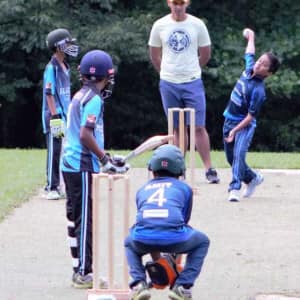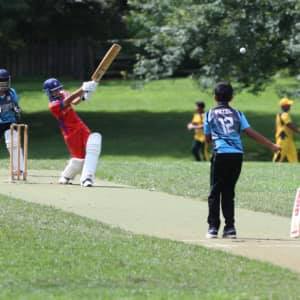Grass roots pioneer Jamie Harrison on the challenges of developing cricket in the USA
With the USA’s men’s side having last week gained One day international status for the next three years, the Sports Gazette spoke to Jamie Harrison, the foremost grass roots cricket administrator and enthusiast in the world’s richest country.
How big will ODI status be for cricket in the USA?
“It’ll be massive, because what it’ll mean is regular high-profile competition. We’ve languished in the lower divisions and you can’t get Americans fired up about a Division 3 or 4 match against a minor country that most of them couldn’t place on a map. But once you tell Americans that this is an important match and the United States is in line to qualify for the World Cup, once you give it a sense of gravitas then the winning and losing becomes significant. The United States men’s team in the last few months has become really, really good. They recently toured the UAE and were kicking butt and taking names, including beating Lancashire,” he said.
“The United States team in the last few months has become really, really good. They recently toured the UAE and were kicking butt and taking names.”
ODI status will mean regular competitive international fixtures for the USA
Twenty 20 is seen as the most likely way for cricket to make a dent on the USA’s sporting consciousness. Would hosting more Twenty 20 internationals in the USA make an impact?
“It would have to be a big tournament. The one offs down in Florida, when you only have a couple of matches to expose it, not a lot of effort or expense goes into marketing it to the mainstream, it’s basically just to the Caribbean expats in South Florida. We need a major cricket event and the marketers of it have to be willing to invest money to take it to the general public, not just the expat population,” he said.
So how did Jamie first come into contact with cricket?
“I was a High School history teacher in Baltimore, and we were on a field trip to an American civil war battlefield. Cricket was demonstrated as an artifact of America’s past, and the boys I was with and myself were asked to play. We all played cricket for about an hour and a half and the boys just absolutely fell in love with it. When we got back to school they asked to start a cricket club, and they asked me if I would be the moderator of the club,” he explained.
“They had no knowledge of the game and no equipment and so we all learned the game together. Eventually within a year we were playing hard ball cricket against a team of Indian and Pakistani kids from Washington DC. I really saw it take off in that year and we all learned quite a bit together. And then they closed down the school!
“I had to make a decision about what I was going to do with cricket. What I’d seen with my kids made me realise that American children would play cricket, if someone just gave them the chance. I had an idea that if someone took cricket equipment to elementary schools and showed kids how to play, they would pick the game up.
“I got Dreamcricket.com to donate ten cricket sets and I started going around elementary schools in Maryland. From that I created the Maryland Youth Cricket Association. Then people all over the country began hearing what I was doing and they wanted to do it in their communities, so then I created the United States Youth Cricket Association. In the end we donated over 2,000 cricket sets to schools all over the United States and instructed hundreds of thousands of kids in how to play cricket.
“In 2016 I left USYCA to focus solely on youth cricket in Maryland. We now have over 500 juniors playing organised cricket in the state of Maryland, which is more than ¼ of the total number of junior cricketers in the whole United States. We have the US’s only schools cricket programme for elementary and middle schools, we have the US’s only state-wide junior cricket championship (now in its seventh season) and we have representative state sides at three different age levels. No other state in the country has even one,” he said.
“What we need to do now is replicate what we’ve done in Maryland all over the country. The problem is right now we’re out there alone. We have 49 other states that need to organise their own youth cricket associations, and that’s what we’re aiming for.”
Living in the USA Jamie’s opportunities to watch professional cricket in person have understandably been few and far between. “I went to the Global T20 in Toronto last summer, that was the first time I’d seen cricket outside of the United States. I’ve been to some Caribbean Premier League matches in Florida, and to the Philadelphia International Cricket Festival for many years, and saw Shiv Chanderpaul play there for the Sarasota club. I’ve seen some cricket but my exposure to the international game is very, very limited,” he said.

However In terms of finding cricket to watch on tv, the situation these days for cricket fans ‘in the know’ in the USA is surprisingly good. “I have subscriptions to Willow TV, Hotstar and ESPN +. On ESPN + they have all of the New Zealand games. Ten years ago you could see the IPL if you had a subscription, but nothing else. Now between Willow, ESPN + and Hotstar I can see almost any match, anywhere, anytime, and I do. During the winters I watch a tonne of Australian cricket,” he said.
So what about cricket appeals to this fan of baseball? “I think it’s more intellectual. It allows more creativity and ingenuity and cunning. In Major League Baseball you’re confined to a batter’s box. Your only strategy is to basically swing hard, there’s really not much else you can do. In cricket because there are no restrictions, anything you can imagine you can do.
“You can go down on one knee and try and hit it over your head, you can slog sweep, nick it around the corner. You have this repertoire of shots almost like a golfer, and you analyse field placements and how the pitch is playing and what the bowlers are giving you and what’s likely to come next, and you select the shot to play. It’s a very cerebral game, it’s far more intellectual than almost any other sport. It’s really a mind battle rather than a brawn battle, between the bowler and the batter. I really get into the strategy of it.
“It’s a very cerebral game, it’s far more intellectual than almost any other sport. It’s really a mind battle rather than a brawn battle, between the bowler and the batter. I really get into the strategy of it.”
“This is why you have cricketers who are forced out of the game because they have psychological breaks. You never hear of an NBA player who left the NBA because they couldn’t take the stress anymore. But you hear of cricketers who are at the top of their form, who just crack under the stress of playing cricket,” he continued.
So how does he encourage kids to give cricket a go in the first place?
“You have to find something unique that appeals to children beyond the other sports. You don’t say ‘We’re gonna replace baseball’. The great thing about the United States is there are 330 million people here. If 1% of the population end up being cricket fans, that’s 3.3 million cricket fans right there. It doesn’t take a big market penetration to have a sizable number of people. More so than any almost any ICC full member nation other than the South Asian countries. So i’m not worried about competing with other sports, we can find our place just like soccer. It’s amazing what can happen once the barriers come down and people are given the chance to appreciate something. I am absolutely confident that given the chance Americans will also come to love cricket,” he said.

And how does he go about getting hold of kit?
“One of the advantages of having 100,000 people who are playing hardball cricket in the United States, is that there are almost always three or four people in every team who know a guy in Pakistan or in India, who can get you cricket equipment at dirt cheap prices. We order almost everything direct from Pakistan. Our team uniforms, full kits for our Under 11s team, cost $30 per uniform, probably no American retailer could compete with that price and the kits are top quality.”
So what is the attitude of your everyday American to cricket, bemusement perhaps?
“I would say bemusement is probably a good word. The general public has very little exposure to cricket. Even though there are half a million people playing recreational cricket of one form or another, mostly tennis ball cricket but some of it hardball, these leagues and these players tend to keep a pretty low profile. Most Americans are only dimly aware of cricket in the United States. I’m convinced that if it hits television or some other way to get it above the radar, everything will change overnight.”
“Most Americans are only dimly aware of cricket in the United States. I’m convinced that if it hits television or some other way to get it above the radar, everything will change overnight.”
However getting cricket onto free to air tv is the big challenge. “It only costs me probably $40 a month to see any match at any time, but someone who’s never seen the game before, they’re not going to know where to go or write a cheque having never seen the sport. They need to trip over it on free to air television somewhere. The kids have never seen it, the parents have never seen it, so they’re reticent to sign their children up for youth cricket. I go into a couple of dozen schools every year teaching cricket to the P.E. classes and even now half of the children in the class have never heard of cricket before,” he explains.
His biggest challenge is finding new volunteers to help run his youth coaching projects. “Volunteers are gold. It’s not the money, we operate on a comparatively small budget, but we have a lot of great volunteers. You always have to be looking at parents as your next assistant coach or your next administrator,” he said.
A problem for promising junior cricketers in the USA is finding a men’s team once they have outgrown junior cricket. “There are two men’s hardball leagues in the Washington DC suburbs, if they want to continue to play. College cricket really doesn’t exist in the United States. There’s always tennis ball cricket too. I’d guess that the men’s leagues are 99.5% expats, but I think that’s going to change in the next 15-20 years as a lot of the kids playing for us were born and raised in America,” he said.
So where does he hope USA cricket will be in ten years’ time?
“I want us to be competing for a world cup. I think at the T20 level we could perhaps have won a world cup, and on the women’s side we’re probably going to win a world cup before the men’s side. Just like women’s soccer in the United States has gone farther faster than the men’s side, I think the same will be true with cricket,” he concluded.
Thanks to Jamie Harrison for allowing the use of three of his photos